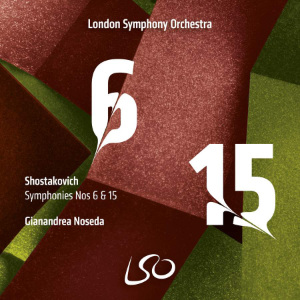
Dmitri Shostakovich (1906-1975)
Symphony No. 15 in A major, Op. 141
Symphony No. 6 in B minor, Op. 54
London Symphony Orchestra/Gianandrea Noseda
rec. live, October 2019 (6), February 2022 (15) Barbican Hall, London
LSO Live LSO0878 SACD [76]
Though all of Shostakovich’s 15 symphonies share elements of style and manner he never repeated himself as far as complete works are concerned. After the monumental Fifth, ‘the practical creative answer of a Soviet artist to just criticism’ as one commentator put it, the Sixth turned out to be a three-movement work lasting half an hour. The first movement, which lasts longer than the other two put together, is a typically brooding Shostakovich opener, sombre, heavy, and with little light relief. The two remaining movements, too, might be seen as something Shostakovich did elsewhere, the first a sardonic scherzo and the finale a mad, circus-like dash to the finish. Just how the first movement relates to the rest of the work is open to discussion, but taken on its own terms the symphony’s form is curiously convincing.
As early as the second page of the score we are aware of the challenges that face engineers recording in the Barbican Hall. The dynamic range of the recording would seem to be perfectly normal, yet fortissimo passages are disconcertingly lacking in impact. Every strand of the orchestral writing is audible, however, an undoubted plus, and perhaps a consequence of a dry acoustic that will not please every listener. The first movement, in common with many such, is string based, but with much important writing for the winds, magnificently executed here. Noseda takes the second movement Scherzo at a relatively measured pace. Petrenko (Naxos), Skrowaczewski with the Hallé, and Barshai in his superb complete survey of the symphonies on Brilliant, all dispatch this movement in less time than Noseda feels the need for, but this will probably only be revealed if listeners do what I did, which it to take down other performances for direct comparison. Something similar happens with the finale, though here it is not so much a question of tempo as one of character and nature. The driving quality of this extraordinary music might put listeners in mind of the finale of Prokofiev’s Fifth Symphony, with an extra dose of rowdiness thrown in. This is certainly present in the Barbican performance, but the performances cited above are rowdier still. Barshai’s performance is so brilliantly integrated, for instance, that the conductor appears to be managing a riot among ballet dancers! And when we turn to older Russian performances – listen to the blaring brass under Mravinsky in a live 1972 Leningrad performance on YouTube – the difference is plain to hear. Now I do not subscribe to the view sometimes expressed that orchestral players are now so proficient that certain works – Le sacre du printemps is a particular sufferer – are often played too well. It is absurd to suggest that a work might be played too well. But the magnificent playing from the London Symphony Orchestra here is perhaps a touch too polite: the odd sign of strain here and there might well have added a little to the success of the reading.
Paradoxically, perhaps, the very dryness of the acoustic serves as an advantage in the Fifteenth Symphony, placed first on the disc. Once again, Shostakovich’s extraordinary orchestral conception is heard, and heard to advantage. The playing is phenomenal, from the lengthy opening flute solo through to every single member of the ensemble. Shostakovich’s own suggested image of a toy shop in respect of the first movement is surely a disingenuous one. These musicians ably fulfil that objective, but there is, of course, much more to it than that. The playing is forthright and trenchant, a perfect combination of playfulness and unsettling ambiguity. The superb LSO brass players come into their own at the opening of the second movement, a long, sombre meditation. There are lengthy passages in which very little happens, but the first cello and those few musicians who accompany brilliantly sustain tension and the listener’s attention. When the inevitable funeral march finally appears it is a pair of flutes that introduce it, passing it later to a lugubrious trombone. This is Shostakovich scoring at its most spare: pages carry much white space, and the enormous climax is typical in having only two simultaneous musical lines. I have rarely heard the third movement Scherzo – 4½ minutes to the previous movement’s 16 – quite so spectral as here. A brief taste of the ticking percussion device that is to close the work is then the strangest introduction to the Wagner quote that opens the finale. The climax of the movement – and of the whole work – is overwhelming, a corrupted version of an earlier passacaglia theme that is recognised as much by its rhythm as by the notes of which it is constructed. And the skill of these players in the extraordinary coda leaves one gasping in admiration.
If the wildness that characterises much of the Sixth Symphony is perhaps a little short-changed here, Noseda’s approach suits Shostakovich’s final symphonic utterance perfectly. It is a mystifying yet deeply moving discourse in which wildness plays no part. This performance from Noseda and the superb London Symphony Orchestra is so satisfying that at no point did I feel the need to compare it to others. I will be returning to it frequently.
William Hedley
Help us financially by purchasing from




















